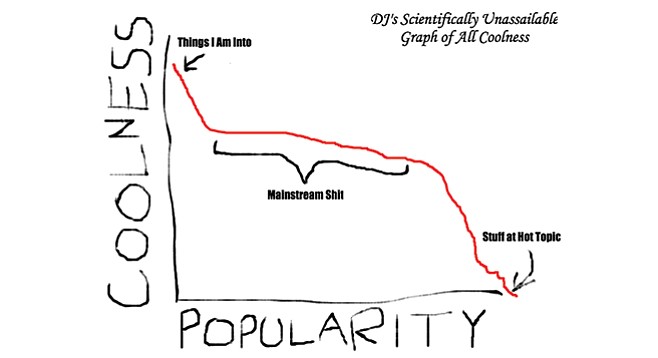 Facebook
Facebook
 X
X
 Instagram
Instagram
 TikTok
TikTok
 Youtube
Youtube

Dear Hipster:
My friend told me she really wants a Herschel backpack, which I notice has become super trendy in the past couple years. This got me thinking about the relative coolness of fashionable clothing and accessories. If something’s super popular and mainstream, how can it be cool? I mean, what’s cool about endorsing an already popular brand?
— Proud Timbuk2 Owner
I’ve probably said this before. “Cool” and “fashionable” are related, but not identical. In general, as something becomes more fashionable (an easy metric to measure), it wanes in coolness (a much more difficult quality to assess). Consider the parallel example of horn-rimmed glasses. In the past century, cool people have periodically rescued horn-rims from perpetual nerdiness, thrusting the black-framed glasses into the fashion spotlight.
Here’s how you can determine if any trend is still cool after it starts to catch on: General Coolness (in SI MegaFonzies) equals the Qualities and Scarcity of an item, multiplied exponentially by the number of References to that thing in classic indie rock songs, divided by the Number of people who were into it before you were, raised by the power equal to endorsement by Teen pop celebrities. In case you’re not so hot on word problems and the order of operations, it can be written out as
C = (Q+S)^R / N^T
for maximum cryptic effect. This is actually a basic equation that doesn’t account for cultural entropy, the special relativistic effects of supercoolness in certain loci, or the so-called “Hot Topic Effect” of terminal uncoolness.


Dear Hipster:
My friend told me she really wants a Herschel backpack, which I notice has become super trendy in the past couple years. This got me thinking about the relative coolness of fashionable clothing and accessories. If something’s super popular and mainstream, how can it be cool? I mean, what’s cool about endorsing an already popular brand?
— Proud Timbuk2 Owner
I’ve probably said this before. “Cool” and “fashionable” are related, but not identical. In general, as something becomes more fashionable (an easy metric to measure), it wanes in coolness (a much more difficult quality to assess). Consider the parallel example of horn-rimmed glasses. In the past century, cool people have periodically rescued horn-rims from perpetual nerdiness, thrusting the black-framed glasses into the fashion spotlight.
Here’s how you can determine if any trend is still cool after it starts to catch on: General Coolness (in SI MegaFonzies) equals the Qualities and Scarcity of an item, multiplied exponentially by the number of References to that thing in classic indie rock songs, divided by the Number of people who were into it before you were, raised by the power equal to endorsement by Teen pop celebrities. In case you’re not so hot on word problems and the order of operations, it can be written out as
C = (Q+S)^R / N^T
for maximum cryptic effect. This is actually a basic equation that doesn’t account for cultural entropy, the special relativistic effects of supercoolness in certain loci, or the so-called “Hot Topic Effect” of terminal uncoolness.
Comments